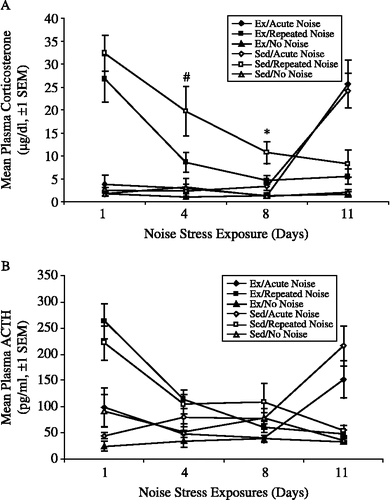Figures & data
Figure 1 Mean body weights (g, ± SEM) for each of the 4 experimental groups (exercised, Ex and sedentary, Sed Repeated Noise, n = 17/group; Ex and Sed No Noise, n = 8/group) over the 8-week duration of Experiment no. 1. Ex rats weighed significantly less than Sed rats at all time points following the initial (Week 0) measurement (p < 0.05).
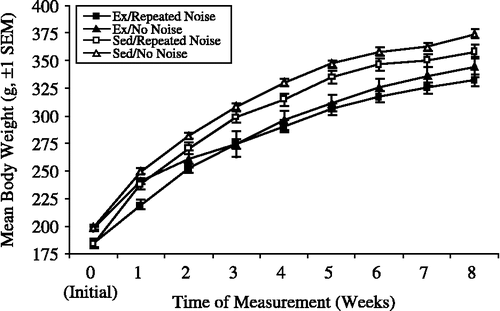
Table I. Mean adrenal and thymus weights (g per 100 g body weight, ±SEM) for rats from Experiment no. 1 that were exercising (Ex) or sedentary (Sed) for 6 weeks prior to 11 consecutive daily 30 min presentations of 98-dB noise stress or 60-dB background noise. There were no effects of Activity Status or Stress Treatment on mean adrenal or thymus weights. n=number of rats providing tissue weight per group.
Figure 2 Mean plasma corticosterone responses (μg/dl, ± SEM) in exercised (Ex) and sedentary (Sed) rats exposed to 11 consecutive daily 30 min presentations of 98-dB noise stress (n = 17/group) or 60-dB background noise (n = 8/group except on Days 8 and 11, where n = 7 for Ex and Sed No Noise groups, respectively, due to missing data) in Experiment no. 1. Asterisks indicate p ≤ 0.05 between Ex and Sed Repeated Noise groups only.
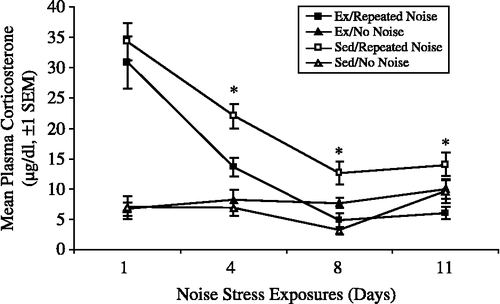
Figure 3 Mean body weights (g, ± SEM) for each of the 6 experimental groups (n = 8/group) over the 8-week duration of Experiment no. 2. Exercised (Ex) rats weighed significantly less than sedentary (Sed) rats at all time points following the initial (Week 0) measurement (p < 0.05).
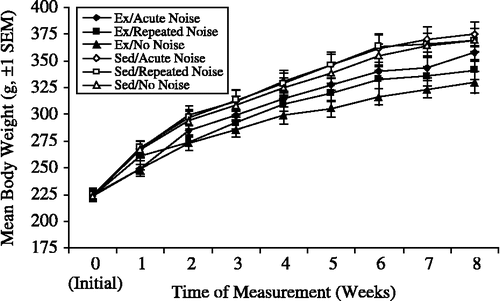
Figure 4 Mean distance traveled per 24-h period, averaged over each week of running wheel access (km, ± SEM), for the 8-week duration of Experiment no. 2, for each of the three Stress Treatment groups (n = 8/group). While individual variation in activity levels was evident, overall group differences were not reliable.
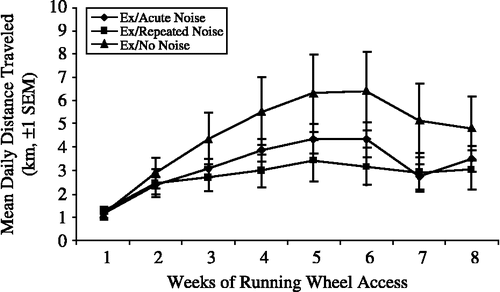
Table II. Mean adrenal and thymus weights (g per 100 g body weight, ±SEM) for rats from Experiment no. 2 that were exercising (Ex) or sedentary (Sed) for 6 weeks prior to 11 consecutive daily 30 min presentations of 98-dB noise stress, 60-dB background noise, or 10 days of background noise followed by one acute 98-dB noise stress presentation on Day 11 of testing. Only a significant main effect of Activity Status on mean adrenal and thymus weights was found such that, as a function of body weight, adrenals weighed more and the thymus weighed less in Ex as compared to Sed rats (p < 0.05).
Figure 5 (A) Mean plasma corticosterone responses (μg/dl, ± SEM) in exercised (Ex) and sedentary (Sed) rats exposed to 11 consecutive days of 30-min 98-dB noise stress, 60-dB background noise, or 10 days of background noise exposures followed by an acute 98-dB noise stress presentation on Day 11 in Experiment no. 2 (n = 8/group except for Ex/Acute Noise and Ex/No Noise groups on Day 11, and Sed/Repeated Noise on Days 4 and 8, where n = 7 due to missing data). Asterisk indicates p ≤ 0.05 and 5 indicates p ≤ 0.10 between Ex and Sed Repeated Noise groups only. (B) Mean plasma ACTH responses (pg/ml, ± SEM) for each of the 6 experimental groups (n = 8/group except for Sed/Repeated Noise on Day 1, where n = 7 due to missing data). No reliable differences were observed between Ex and Sed Repeated Noise groups on any of the 4 sampling days.
